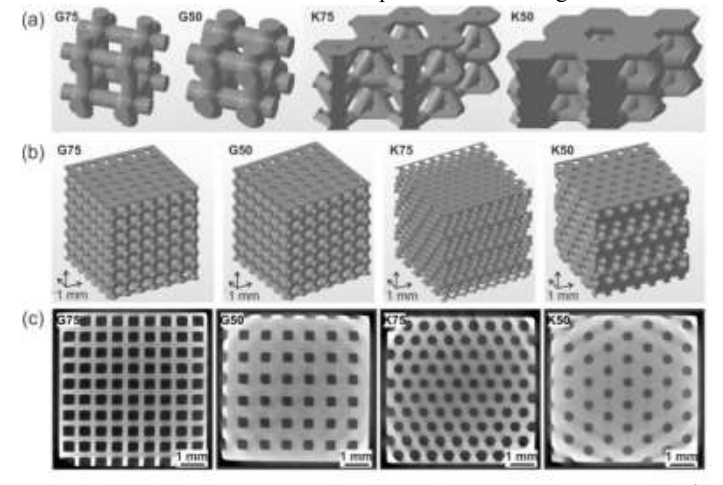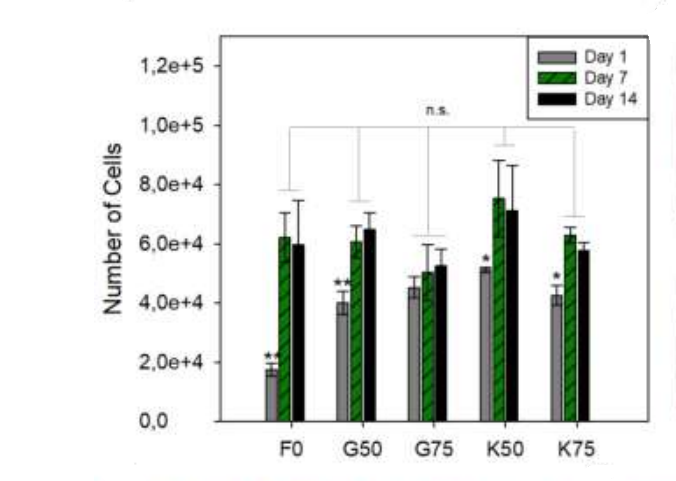With a Focus on DLP: Researchers 3D Printing High Resolution Tricalcium Phosphate Scaffolds for Bone Regeneration
In ‘Application of high resolution DLP stereolithography for fabrication of tricalcium phosphate scaffolds for bone regeneration,’ researchers examine how to make complex, stable scaffolds based on β-tricalcium. Typically, there are obstacles to finding materials and techniques suitable for creating structures capable of sustaining cell life.
Here, the authors are aware of the necessities in tissue engineering: the material cannot be toxic, obviously, as that would cause further health issues in a patient, biodegradability is key, with the material being absorbed along with suitable bone growth, and porosity and density must be suitable too, balanced out with proper strength.

(a): CAD of an assembly of 8 unit cells for the Grid structures and 1 unit cell for the Kagome structures; not to scale. (b): CAD of 6 mm cubes of the four scaffold types. (c): µ-CT slices in the x, y-plane of the scaffolds after filtering.
DLP 3D printing has proven successful for creating scaffolds due to comprehensive irradiation over the whole cross-section, and shorter processing times in comparison to other processes. The researchers focused on DLP 3D printing for this study, in relation to the use of calcium phosphate structures that are not only complex and high resolution but also strong. The team assessed both rectilinear grid structure and hexagonal geometries (at 50 and 75 percent porosity) for mechanical properties, with complete chemical analyses performed before and after bioprinting.
“Preosteoblast MC3T3 cells were used to evaluate biocompatibility of 3D printed scaffolds by DLP process and their ability to form bone in short term culture,” explained the authors.
In scaffold design, both the rectilinear grid structure and a hexagonal Kagome structure were created at two different levels of porosity, along with one non-porous specimen. All the designs were treated with scaling factors also, to compensate for shrinkage (1.267 in x, y directions and of 1.281 in z-direction).
The rectilinear grid structures were able to handle over twice the capacity of the Kagome scaffolds, which the authors attributed to ‘inhomogeneous stress distributions in the latter architectures.’ They also noted discontinuities in the Kagome structures, likely caused by cells failing under loading. The researchers also noted elevated activity in porous scaffolds on day one after seeding—perhaps due to ‘inhomogeneous seeding resulting in inconsistent areas of confluency and thereby in a broader range of onset time of differentiation.’ Increased ALP activity could be caused by osteogenic differentiation, however.

Representative stress-strain curves of scaffolds and of the nonporous F0 structure in compression. Distinct pop-in events marked with *.
“The DLP process does not negatively impact the attained results and it, as well as the utilized material, can therefore be considered as biocompatible,” concluded the researchers. “Thus, the presently manufactured β-TCP structures are promising for applications in bone regeneration as scaffolds and could also be employed as a starting point for composite structures. For instance, in approaches where a ceramic framework is coated or impregnated with a polymer, a solid and reproducible scaffold foundation, such as described in the present paper is vital.”
Bone regeneration is one of the hottest topics lately, mainly because it is an area of great challenge for researchers and medical professionals, who are continually trying to improve quality of life for patients around the world, through researching new materials meant for bioprinting, fabricating new scaffolding, and even bioprinting in situ. What do you think of this news? Let us know your thoughts! Join the discussion of this and other 3D printing topics at 3DPrintBoard.com.

Cell number from DNA quantification of the different 3D scaffolds in osteogenic medium; n = 3, with SD, n.s. for no statistically significant difference, * for P ≤ 0.005, and ** for P < 0.001.
Subscribe to Our Email Newsletter
Stay up-to-date on all the latest news from the 3D printing industry and receive information and offers from third party vendors.
You May Also Like
Further Understanding of 3D Printing Design at ADDITIV Design World
ADDITIV is back once again! This time, the virtual platform for additive manufacturing will be holding the first-ever edition of ADDITIV Design World on May 23rd from 9:00 AM –...
3D Printer Maker EVO-tech Reborn as NEVO3D — Once More With Feeling
EVO-tech was a 3D printing service and original equipment manufacturer established in 2013 and based in Schörfling am Attersee, Austria. The company produced high-quality material extrusion systems featuring linear bearings,...
3D Systems Brings 3D Printed PEEK Cranial Implant to the U.S. with FDA Clearance
For more than 10 years, 3D Systems (NYSE:DDD) has worked hand-in-hand with surgeons to plan over 150,000 patient-specific cases, and develop more than two million instruments and implants from its...
CDFAM Returns to Berlin for Second Annual Symposium
The second CDFAM Computational Design Symposium is scheduled for May 7-8, 2024, in Berlin, and will convene leading experts in computational design across all scales. Building upon the first event...































